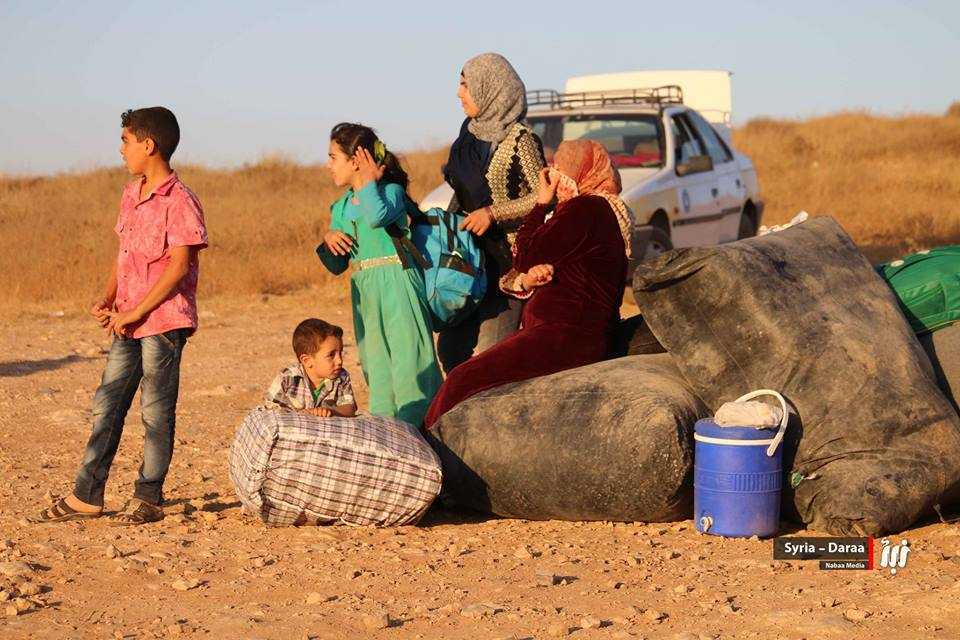Syrian family returns to Daraa province after three years in Jordanian refugee camp: ‘There was no future’
Three weeks ago, Naima, a 34-year-old Syrian refugee and mother […]
14 September 2017
Three weeks ago, Naima, a 34-year-old Syrian refugee and mother of three, forfeited her asylum status in Jordan and boarded a bus that took her and her children from the Zaatari refugee camp back to Syria.
After three years of living as a refugee in Jordan, Naima was headed home.
In July, the United States, Russia and Jordan agreed to a major de-escalation deal in southern Syria that essentially designated Naima’s native Daraa province in southern Syria as a safe zone—almost entirely halting violence between the opposition and government forces battling for control of the area.
“We tasted the bitterness of life in those camps,” she tells Syria Direct’s Bahira al-Zarier. “When the bombings stopped…we decided to voluntarily return.”
More than 1,300 families previously seeking refuge in Jordan have returned to Daraa province since the de-escalation deal went into effect, a member of the opposition’s Provincial Council told Syria Direct this month.

Naima and her children now live at the family’s home in Daraa al-Balad, the rebel-held southern half of Daraa’s provincial capital. In late July, the area was nearly 90% destroyed, Syria Direct reported at the time.
“I will struggle to take care of my children here just as I did in Jordan,” she says.
“The difference is that here, in Daraa, I am living in my own country.”
(Click here for Syria Direct’s full report on the return of refugees to southern Syria.)
Q: Why did you decide to return to Daraa?
I chose to return because our lives weren’t improving as refugees.
Our lives were limited to securing our daily needs—ensuring that we have water, going out to buy food and doing housework. We tasted the bitterness of life in those camps. When the bombing stopped and Daraa became a part of a de-escalation agreement, we decided to go back voluntarily.
There was no future for our children [in the camp]. They didn’t even have dreams outside of the [camp] walls.
Q: Can you describe the process you went through in order to return?
The procedures were easy. I went to the camp administration in Zaatari and made a request to return. After getting permission, there were weekly buses to transport those wishing to return to Syria. We were taken to the Naseeb [crossing] and from there to our towns. Of course, before leaving Jordan we turned over the UNHCR documentation and magnetized IDs that we had received in the camp.
Q: In your opinion, has southern Syria become a safe region? Do you fear that violence will return?
Yes, I see it as safe. After the de-escalation agreement took effect, rumors spread in the camps that everyone would be moved to the safe zones. I read these rumors on a number of Facebook pages.
The most important thing for me is that the bombing doesn’t return again to my town. As for my lifestyle—I will struggle to take care of my children here just as I did in Jordan. The difference is just that here, in Daraa, I am living in my own country.
Of course I have fears that the bombing will return, but we grew tired of waiting for victory in order to return. Life is was very difficult [in Jordan] and exile stole the happiness from our hearts and our children’s hearts. All we can do is pray that the de-escalation agreement remains in place.
Q: Describe life in Jordan. What were the difficulties and challenges you faced there?
Our life in Jordan was a camp in the desert. We lived in caravans and relied on aid provided by the UN and other organizations.
Life had no flavor, just feelings of alienation and that nothing would get better. There was no future on the horizon.
We couldn’t acclimate to the reality we lived in the camp. Our children began to think the camp was our country! Isn’t that awful?
This interview is part of Syria Direct’s month-long coverage of the state of the south in partnership with the Konrad Adenauer Foundation and reporters on the ground in Syria. Read our primer on southern Syria here.








